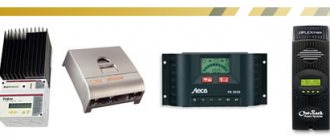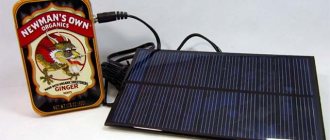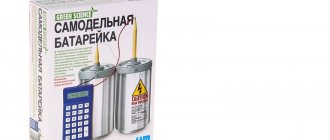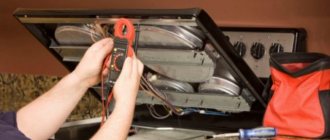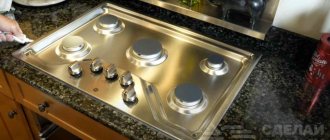There are often messages online about the fight for the environment and the development of alternative energy sources. Sometimes they even report on how a solar power plant was built in an abandoned village so that local residents could enjoy the benefits of civilization not 2-3 hours a day while the generator is running, but constantly. But this is all somehow far from our life, so I decided to use my own example to show and tell how a solar power plant for a private home is structured and how it works. I’ll tell you about all the stages: from the idea to turning on all the devices, and I’ll also share my operating experience. The article will be quite long, so those who don’t like a lot of letters can watch the video. There I tried to tell the same thing, but it will be seen how I collect all this myself.
Initial data: a private house with an area of about 200 m2 is connected to the power grid. Three-phase input, total power 15 kW. The house has a standard set of electrical appliances: refrigerators, televisions, computers, washing machines, dishwashers, and so on. The power grid is no different in terms of stability: the record I recorded was a blackout for 6 days in a row for a period of 2 to 8 hours.
What you want to get: forget about power outages and use electricity no matter what.
What bonuses could there be: Maximize the use of solar energy, so that the house is primarily powered by solar energy, and the deficiency is taken from the network. As a bonus, after the adoption of the law on the sale of electricity to the grid by private individuals, begin to compensate for part of their costs by selling excess generation to the general power grid.
Where to begin?
There are always at least two ways to solve any problem: study yourself or entrust the solution to someone else. The first option involves studying theoretical materials, reading forums, communicating with owners of solar power plants, fighting internal toads and, finally, purchasing equipment, and then installation. The second option: call a specialized company, where they will ask a lot of questions, select and sell the necessary equipment, and maybe install it for some money. I decided to combine these two methods. Partly because it’s interesting to me, and partly in order not to run into sellers who just want to make money by selling something that’s not exactly what I need. Now it's time for theory to understand how I made my choices.
The photo shows an example of “using” money for the construction of a solar power plant. Please note that the solar panels are installed BEHIND the tree - so no light reaches them and they simply do not work.
Types of solar power plants
Let me note right away that I will not be talking about industrial solutions or heavy-duty systems, but about an ordinary consumer solar power plant for a small home. I am not an oligarch to throw money away, but I adhere to the principle of being reasonably reasonable. That is, I don’t want to heat the pool with “solar” electricity or charge an electric car that I don’t have, but I want all the appliances in my house to work all the time, without regard to the power grid.
Now I’ll tell you about the types of solar power plants for a private home. By and large, there are only three of them, but there are variations. I will arrange them according to the increase in cost of each system.
Network Solar Power Plant - this type of power plant combines low cost and maximum ease of operation. It consists of only two elements: solar panels and a network inverter. Electricity from solar panels is directly converted to 220V/380V in the home and consumed by the home power systems. But there is a significant drawback: the ESS requires a backbone network to operate. If the external power grid is turned off, the solar panels will turn into a “pumpkin” and stop producing electricity, since the operation of the grid-connected inverter requires a support network, that is, the very presence of electricity. In addition, with the existing power grid infrastructure, operating a grid-tied inverter is not very profitable. Example: you have a 3 kW solar power plant, and your house consumes 1 kW. The excess will “flow” into the network, and conventional meters count energy “modulo”, that is, the energy supplied to the network will be counted by the meter as consumed, and you will still have to pay for it. The logical question here is: what to do with excess energy and how to avoid it? Let's move on to the second type of solar power plants.
Hybrid Solar Power Plant – this type of power plant combines the advantages of a networked and autonomous power plant. Consists of 4 elements: solar panels, solar controller, batteries and hybrid inverter. The basis of everything is a hybrid inverter, which is capable of mixing the energy generated by solar panels into the energy consumed from the external network. Moreover, good inverters have the ability to prioritize the energy consumed. Ideally, the house should first consume energy from solar panels and only if there is a shortage of it, get it from the external network. If the external network disappears, the inverter goes into autonomous operation and uses energy from solar panels and energy stored in batteries. This way, even if the power goes out for a long time and it’s a cloudy day (or the power goes out at night), everything in the house will function. But what to do if there is no electricity at all, but you need to live somehow? Here I move on to the third type of power plant.
Autonomous Solar Power Plant - this type of power plant allows you to live completely independently of external power grids. It may include more than 4 standard elements: solar panels, solar controller, battery, inverter.
In addition to this, and sometimes instead of solar panels, a low-power HydroElectroStation, a wind power plant, or a generator (diesel, gas or gasoline) can be installed. As a rule, such facilities have a generator, since there may be no sun and wind, and the energy supply in the batteries is not infinite - in this case, the generator starts up and provides energy to the entire facility, simultaneously charging the battery. Such a power plant can easily be transformed into a hybrid one by connecting an external power supply network, if the inverter has these functions. The main difference between an autonomous inverter and a hybrid one is that it cannot mix energy from solar panels with energy from an external network. At the same time, the hybrid inverter, on the contrary, can work as an autonomous one if the external network is turned off. As a rule, hybrid inverters are comparable in price to fully autonomous ones, and if they differ, it is not significant.
Why extract electricity from the ground?
In order to generate electricity, you need to find a potential difference and a conductor. By connecting everything into a single flow, you can provide yourself with a constant source of electricity. However, in reality, taming the potential difference is not so simple.
Nature conducts enormous power of electricity through a liquid medium. These are lightning discharges, which are known to occur in air saturated with moisture. However, these are just single discharges, and not a constant flow of electricity.
Man took on the function of natural power and organized the movement of electricity through wires. However, this is just a transfer of one type of energy to another. Extracting electricity directly from the environment remains mainly at the level of scientific research, experiments in the category of entertaining physics and the creation of small low-power installations.
The easiest way to extract electricity is from a solid and moist environment.
What is a solar controller?
All types of solar power plants have a solar controller. Even in a grid-connected solar power plant it is present, it is simply part of the grid-connected inverter. And many hybrid inverters are produced with solar controllers on board. What is it and what is it for? I will talk about a hybrid and autonomous solar power plant, since this is exactly my case, and I can tell you more about the design of a network inverter in the comments if there are any requests in the comments.
A solar controller is a device that converts the energy received from solar panels into energy digested by an inverter. For example, solar panels are manufactured with a voltage that is a multiple of 12V. And batteries are manufactured in multiples of 12V, that’s just the way it is. Simple systems with 1-2 kW power operate on 12V. Productive systems of 2-3 kW already operate on 24V, and powerful systems of 4-5 kW or more operate on 48V. Now I will consider only “home” systems, because I know that there are inverters operating at voltages of several hundred volts, but this is already dangerous for the home.
So, let's say we have a 48V system and 36V solar panels (the panel is assembled in multiples of 3x12V). How to get the required 48V to operate the inverter? Of course, a 48V battery is connected to the inverter, and a solar controller is connected to these batteries on one side and solar panels on the other. Solar panels are assembled at a deliberately higher voltage in order to be able to charge the battery. The solar controller, receiving obviously higher voltage from the solar panels, transforms this voltage to the required value and transmits it to the battery. This is simplified. There are controllers that can reduce 150-200 V from solar panels to 12 V batteries, but very large currents flow here and the controller operates with worse efficiency. The ideal case is when the voltage from the solar panels is twice the voltage on the battery.
There are two types of solar controllers: PWM (PWM - Pulse Width Modulation) and MPPT (Maximum Power Point Tracking). The fundamental difference between them is that the PWM controller can only work with panel assemblies that do not exceed the battery voltage. MPPT - the controller can operate with a noticeable excess of voltage relative to the battery. In addition, MPPT controllers have noticeably higher efficiency, but are also more expensive.
Alternative energy sources for powering a cottage or home
In modern cities there is a high concentration of the population, which is supplied with high quality electrical energy. But in rural areas, characterized by long air transmission lines, this issue has not been fully resolved.
The voltage supplied to buildings located at the remote ends of power lines is not only unstable, but can be switched off for various reasons.
In this situation, people are looking for alternative sources of electrical energy that are capable of maintaining normal power supply in their country houses and private homes.
Our advice will help the home handyman choose the most suitable type of generator, which is optimal for restoring voltage while troubleshooting faults on the supply power line or will allow you to use its power for a constant power supply.
Brief information about the capabilities of a home power station
The term “generator” refers to technical devices capable of generating electric current by converting some source energy into electricity. For example, in a car it is created due to the mechanical rotation of the rotor inside the stator, and in a solar battery - as a result of irradiation of sensitive photocells with sunlight.
Electric generators are produced in a wide range and perform various power supply tasks. To correctly select an alternative energy source, it must be accurately analyzed according to its characteristics:
- maximum load power;
- types of electric current: constant or sinusoidal;
- consumer parameters (resistive or reactive load) that influenced startup and operation;
- working cycle duration;
- activation methods: manual or automatic mode;
- other specific operating conditions.
This means that one alternative energy source is capable of autonomously providing electrical power not only to a private house, but also to a village, while another can barely cope with the power of consumers in one apartment. But their cost will differ by several orders of magnitude.
Minimum requirements for a home power source
Before choosing the simplest generator for your home, you should consider only the main appliances that it must power and select it according to their parameters. For example, if the electricity is turned off for just a few hours, then you can exclude the operation of refrigerators and freezers, since they are able to keep the cold during this period.
An ordinary car battery with a voltage of 12 volts of any power, but preferably increased power, can provide the minimum functions of a budget source of electrical energy. You can connect to it:
- backup lighting based on several LED lamps;
- laptop, computer or digital TV directly to the output circuits of the power supply. This eliminates the double conversion of direct and alternating voltages of 12 volts to 220 and back.
The battery will power these devices and gradually discharge. To recharge it, it is enough to use a generator removed from the car, the rotor of which can be turned with a bicycle trainer.
For this purpose, the rear wheel of the bicycle is simply hung on a stand, and a second chain is installed on one of its free sprockets, which will transmit torque from the pedals to the rotor of the car generator.
Any other available method of transferring rotational energy can be used, for example, by creating direct contact from the wheel tire directly to the tip of the rotor axle.
Due to such a simple design, it is convenient to exercise on an exercise bike and at the same time watch television programs or use the Internet from a laptop or computer. In conditions of lack of physical activity, this is a pretty good way to maintain health and at the same time save energy for the home.
How to choose solar panels?
At first glance, all solar panels are the same: the cells of solar cells are interconnected by busbars, and on the back side there are two wires: plus and minus. But there are a lot of nuances in this matter. Solar panels come from different elements: amorphous, polycrystalline, monocrystalline. I will not advocate for one type of element or another. Let me just say that I myself prefer monocrystalline solar panels. But that's not all. Each solar battery is a four-layer cake: glass, transparent EVA film, solar cell, sealing film. And here every stage is extremely important. Not just any glass is suitable, but with a special texture, which reduces the reflection of light and refracts light incident at an angle so that the elements are illuminated as much as possible, because the amount of energy generated depends on the amount of light. The transparency of the EVA film determines how much energy reaches the element and how much energy the panel generates. If the film turns out to be defective and becomes cloudy over time, then production will drop noticeably.
Next come the elements themselves, and they are distributed by type, depending on quality: Grade A, B, C, D and so on. Of course, it is better to have quality A elements and good soldering, because with poor contact, the element will heat up and fail faster. Well, the finishing film should also be of high quality and provide good sealing. If the panels become depressurized, moisture will quickly enter the elements, corrosion will begin, and the panel will also fail.
How to choose the right solar panel? The main manufacturer for our country is China, although there are also Russian manufacturers on the market. There are a lot of OEM factories that will paste any ordered nameplate and send the panels to the customer. And there are factories that provide a full production cycle and are able to control product quality at all stages of production. How can you find out about such factories and brands? There are a couple of reputable laboratories that conduct independent tests of solar panels and openly publish the results of these tests. Before purchasing, you can enter the name and model of the solar panel and find out how well the solar panel matches the stated characteristics. The first laboratory is the California Energy Commission, and the second European laboratory is TUV. If the panel manufacturer is not on these lists, then you should think about quality. This doesn't mean the panel is bad. It’s just that the brand may be OEM, and the manufacturing plant also produces other panels. In any case, the presence in the lists of these laboratories already indicates that you are not buying solar panels from a fly-by-night manufacturer.
Bacteria for biochemical energy generation
Many inventors around the world are engaged in generating electricity using various microorganisms. Researchers from the St. Petersburg State Electrotechnical University "LETI" have created a prototype of a biofuel plant for generating electricity using strains of blue-green algae Anabaena and Synechococcus, which have a bacterial cell structure. These algae are able to use sunlight for energy, water as an electron donor, and carbon dioxide from the air to produce carbon-containing compounds.
A laboratory model of an algae-based biofuel cell was able to generate electricity when exposed to sunlight. To increase the efficiency of the installation, St. Petersburg scientists optimized the parameters of nanostructured anodes made of various carbon materials on which microorganisms were deposited. A cell with the Synechococcus bacterium on a hybrid carbon anode showed the highest efficiency - 183 mW/sq. m.
My choice of solar power plant
Before purchasing, it is worth outlining the range of tasks that are set for the solar power plant, so as not to pay for what is unnecessary and not to overpay for what is not used.
Here I will move on to practice, how and what I did myself. To begin with, the goal and the starting points: in the village the electricity is periodically cut off for a period of half an hour to 8 hours. Outages are possible either once a month or for several days in a row. Task: to provide the house with power supply around the clock with some limitation of consumption during the period of shutdown of the external network. At the same time, the main security and life support systems must function, that is: the pumping station, the video surveillance and alarm system, the router, the server and the entire network infrastructure, lighting and computers, and the refrigerator must work. Secondary: TVs, entertainment systems, power tools (lawn mower, trimmer, garden watering pump). You can turn off: the boiler, electric kettle, iron and other heating and high-consuming devices, the operation of which is not immediately important. The kettle can be boiled on a gas stove and ironed later. Typically, you can buy a solar power plant from one place. Solar panel sellers also sell all the related equipment, so I started my search with solar panels as my starting point. One of the reputable brands is TopRay Solar. There are good reviews about them and real operating experience in Russia, in particular in the Krasnodar Territory, where they know a lot about the sun. In the Russian Federation there is an official distributor and dealers by region, on the above-mentioned sites with laboratories for testing solar panels, this brand is present and is not in last place, that is, you can take it. In addition, the company that sells solar panels, TopRay, also produces its own controllers and electronics for road infrastructure: traffic management systems, LED traffic lights, flashing signs, solar controllers, etc. Out of curiosity, I even asked for their production - it’s quite technologically advanced and there are even girls who know which way to approach the soldering iron. Happens!
With my wish list, I turned to them and asked them to put together a couple of configurations for me: more expensive and cheaper for my home. I was asked a number of clarifying questions about reserved power, availability of consumers, maximum and constant power consumption. The latter actually turned out to be unexpected for me: a house in energy saving mode, when only video surveillance systems, security systems, Internet connections and network infrastructure are working, consumes 300-350 W. That is, even if no one uses electricity at home, up to 215 kWh per month is spent on internal needs. This is where you’ll think about conducting an energy audit. And you’ll start unplugging chargers, TVs, and set-top boxes from the sockets, which consume a little bit in standby mode, but still consume a fair amount of power. I won’t agonize over it, I settled on a cheaper system, since often up to half the amount for a power plant can be taken up by the cost of batteries. The list of equipment is as follows:
- Solar battery TopRay Solar 280 W Mono – 9 pcs
- Single-phase Hybrid inverter 5 kW InfiniSolar V-5K-48 – 1 pc.
- AGM battery Parus HML-12-100 – 4 pcs.
Additionally, I was offered to purchase a professional system for attaching solar panels to the roof, but after looking at the photos, I decided to make do with homemade mounts and also save money. But I decided to assemble the system myself and spared no effort and time, and installers work with these systems constantly and guarantee quick and high-quality results. So decide for yourself: it’s much more pleasant and easier to work with factory fasteners, and my solution is simply cheaper.
What does a solar power plant provide?
This kit can produce up to 5 kW of power in autonomous mode - this is exactly the power I chose a single-phase inverter. If you purchase the same inverter and an interface module for it, you can increase the power to 5 kW + 5 kW = 10 kW per phase. Or you can make a three-phase system, but for now I’m content with that. The inverter is high-frequency, and therefore quite light (about 15 kg) and takes up little space - it can be easily mounted on the wall. It already has 2 MPPT controllers with a power of 2.5 kW each built-in, which means I can add as many more panels without purchasing additional equipment.
I have 2520 W solar panels according to the nameplate, but due to the non-optimal installation angle they produce less - the maximum I saw was 2400 W. The optimal angle is perpendicular to the sun, which in our latitudes is approximately 45 degrees to the horizon. My panels are installed at 30 degrees.
The battery assembly is 100A*h 48V, that is, 4.8 kW*h is stored, but it is extremely undesirable to take the energy completely, since then their resource is noticeably reduced. It is advisable to discharge such batteries no more than 50%. These lithium iron phosphate or lithium titanate ones can be charged and discharged deeply and with high currents, while lead-acid ones, be they liquid, gel or AGM, are better not to force. So, I have half the capacity, which is 2.4 kWh, that is, about 8 hours in fully autonomous mode without the sun. This is enough for the night of operation of all systems and there will still be half of the battery capacity left for emergency mode. In the morning the sun will already rise and begin to charge the battery, at the same time providing the house with energy. That is, the house can function autonomously in this mode if energy consumption is reduced and the weather is good. For complete autonomy, it would be possible to add more batteries and a generator. After all, in winter there is very little sun and you will not be able to do without a generator.
Air generator
The protein fibers (nanowires) produced by Geobacter microbes turned out to be conductive, which allowed one of the laboratories at the University of Massachusetts at Amherst to create the Air-gen pneumatic generator.
The principle of operation of the device: the lower and upper edges of a thin, up to 10 microns, film touch comparable (miniature) electrodes. The film adsorbs water molecules, or more precisely, steam from the air, creating a voltage gradient. The conditions for generating electric current are influenced by the combination of electrical conductivity and chemical composition of the outer surface of the protein fibers, as well as the size of the pores between the fibers in the film. According to the inventors, Air-gen will be able to generate electricity even in the driest regions.
A laboratory prototype of the device on a 7-μm-thick film made it possible to achieve a constant voltage of about 0.5 V with a current density of 17 μA/cm2. It is quite enough to provide power to small-sized electronics, for example, smart watches, fitness bracelets, smartphones, especially if it is produced in the form of a patch.
I'm starting to collect
Before purchasing and assembling, it is necessary to calculate the entire system so as not to make a mistake with the location of all systems and cable routing. From the solar panels to the inverter I have about 25-30 meters and I laid two flexible wires with a cross-section of 6 sq. mm in advance, since they will transmit voltage up to 100V and a current of 25-30A. This cross-sectional margin was chosen to minimize losses on the wire and maximize energy delivery to the devices. I mounted the solar panels themselves on homemade guides made of aluminum corners and attached them with homemade fasteners. To prevent the panel from sliding down, a pair of 30mm bolts point upward on the aluminum corner opposite each panel, and they act as a kind of “hook” for the panels. After installation they are not visible, but they continue to bear the load.
The solar panels were assembled into three blocks of 3 panels each. In the blocks, the panels are connected in series - this way the voltage was raised to 115V without load and the current was reduced, which means you can choose wires of a smaller cross-section. The blocks are connected in parallel to each other using special connectors that ensure good contact and tightness of the connection - called MC4. I also used them to connect wires to the solar controller, as they provide reliable contact and quick closing/opening of the circuit for maintenance.
Next we move on to installation in the house. The batteries are pre-charged with a smart car charger to equalize the voltage and are connected in series to provide 48V. Next, they are connected to the inverter with a cable with a cross-section of 25 mm square. By the way, when you first connect the battery to the inverter, there will be a noticeable spark at the contacts. If you have not mixed up the polarity, then everything is fine - the inverter has fairly capacious capacitors installed and they begin to charge the moment they are connected to the batteries. The maximum power of the inverter is 5000 W, which means the current that can pass through the wire from the battery will be 100-110A. The selected cable is sufficient for safe operation. After connecting the battery, you can connect the external network and the load at home. Wires are attached to the terminal blocks: phase, neutral, ground. Everything here is simple and clear, but if it is unsafe for you to repair the outlet, then it is better to entrust the connection of this system to experienced electricians. Well, the last element is connecting the solar panels: here, too, you need to be careful and not mix up the polarity. With a power of 2.5 kW and incorrect connection, the solar controller will burn out instantly. What can I say: with such power, you can weld directly from solar panels, without a welding inverter. This will not improve the health of solar panels, but the power of the sun is really great. Since I additionally use MC4 connectors, it is simply impossible to reverse the polarity during the initial correct installation.
Everything is connected, one click of the switch and the inverter goes into setup mode: here you need to set the battery type, operating mode, charging currents, etc. There are quite clear instructions for this, and if you can cope with setting up the router, then setting up the inverter will not be very difficult either. You just need to know the battery parameters and configure them correctly so that they last as long as possible. After that, hmm... After that comes the fun part.
Homemade hydroelectric power station
If there is a stream or reservoir with a dam on the site, a homemade hydroelectric power station will become an additional source of alternative electricity. The device is based on a water wheel, and the power will depend on the speed of the water flow. The materials for making a generator and wheels can be taken from a car, and scraps of corner and metal can be found in any household. In addition, you will need a piece of copper wire, plywood, polystyrene resin and neodymium magnets.
Homemade hydroelectric power station
Sequence of work:
- The wheel is made from 11 inch rims. The blades are made from a steel pipe (we cut the pipe lengthwise into 4 parts). 16 blades will be required. The discs are bolted together, the gap between them is 10 inches. The blades are welded.
- The nozzle is made according to the width of the wheel. It is made from scrap metal, bent to size and joined by welding. The nozzle is adjusted in height. This will allow you to adjust the water flow.
- The axle is welded.
- The wheel is installed on the axle.
- The winding is made, the coils are filled with resin - the stator is ready. We assemble the generator. A template is made from plywood. Install magnets.
- The generator is protected by a metal wing from water splashes.
- The wheel, axle and fasteners with nozzle are coated with paint to protect the metal from corrosion and for aesthetic pleasure.
- By adjusting the nozzle, maximum power is achieved.
Homemade devices do not require large capital investments and produce energy for free. If you combine several types of alternative sources, then such a step will significantly reduce energy costs. To assemble the unit you will only need skillful hands and a clear head.
Operation of a hybrid solar power plant
After the launch of the solar power plant, my family and I revised many of our habits. For example, if previously the washing machine or dishwasher started after 11 pm, when the night tariff in the power grid worked, now these energy-consuming jobs are moved to the day, because the washing machine consumes 500-2100 W during operation, the dishwasher consumes 400-2100 W. Why such a spread? Because pumps and motors consume little, but water heaters are extremely power-hungry. Ironing also turned out to be “more profitable” and more enjoyable during the day: the room is much lighter, and the energy of the sun completely covers the consumption of the iron. The screenshot shows a graph of energy production from a solar power plant. The morning peak is clearly visible, when the washing machine was working and consuming a lot of energy - this energy was generated by solar panels.
The first days I went up to the inverter several times to look at the production and consumption screen. Then I installed the utility on my home server, which displays the operating mode of the inverter and all parameters of the power grid in real time. For example, the screenshot shows that the house consumes more than 2 kW of energy (AC output active power item) and all this energy is borrowed from solar panels (PV1 input power item). That is, the inverter, operating in hybrid mode with priority power from the sun, completely covers the energy consumption of the devices from the sun. Isn't this happiness? Every day a new column of energy production appeared in the table and this could not but rejoice. And when the electricity was turned off in the entire village, I found out about it only from the squeak of the inverter, which notified me that it was working in autonomous mode. For the whole house, this meant only one thing: we live as before, while the neighbors fetch water with buckets.
But there are some nuances to having a solar power plant at home:
- I started noticing that birds love solar panels and when they fly over them, they cannot help but be happy about the presence of technological equipment in the village. That is, sometimes solar panels still need to be washed to remove traces and dust. I think that if installed at 45 degrees, all traces would simply be washed away by rain. The output from several bird tracks does not drop at all, but if part of the panel is shaded, the drop in output becomes noticeable. I noticed this when the sun began to set and the shadow from the roof began to cover the panels one after another. That is, it is better to place the panels away from all structures that can shade them. But even in the evening, with diffused light, the panels produced several hundred watts.
- With high power of solar panels and pumping of 700 Watts or more, the inverter turns on the fans more actively and they become audible if the door to the technical room is open. Here you either close the door or mount the inverter on the wall using damping pads. In principle, nothing unexpected: any electronics heats up during operation. You just need to take into account that the inverter should not be hung in a place where it can interfere with the sound of its operation.
- The proprietary application can send alerts by email or SMS if any event occurs: turning on/off an external network, low battery, etc. But the application works on unsecured SMTP port 25, and all modern email services, like gmail.com or mail.ru, work on secure port 465. That is, now, in fact, email notifications do not arrive, but I would like to.
Not to say that these points are somehow upsetting, because one should always strive for perfection, but the existing energy independence is worth it.



